Unit 03
Historical Background
Unit 03
Historical Background
Chapter 01
Ancient Judaea (4000 – 1040 B.C.)
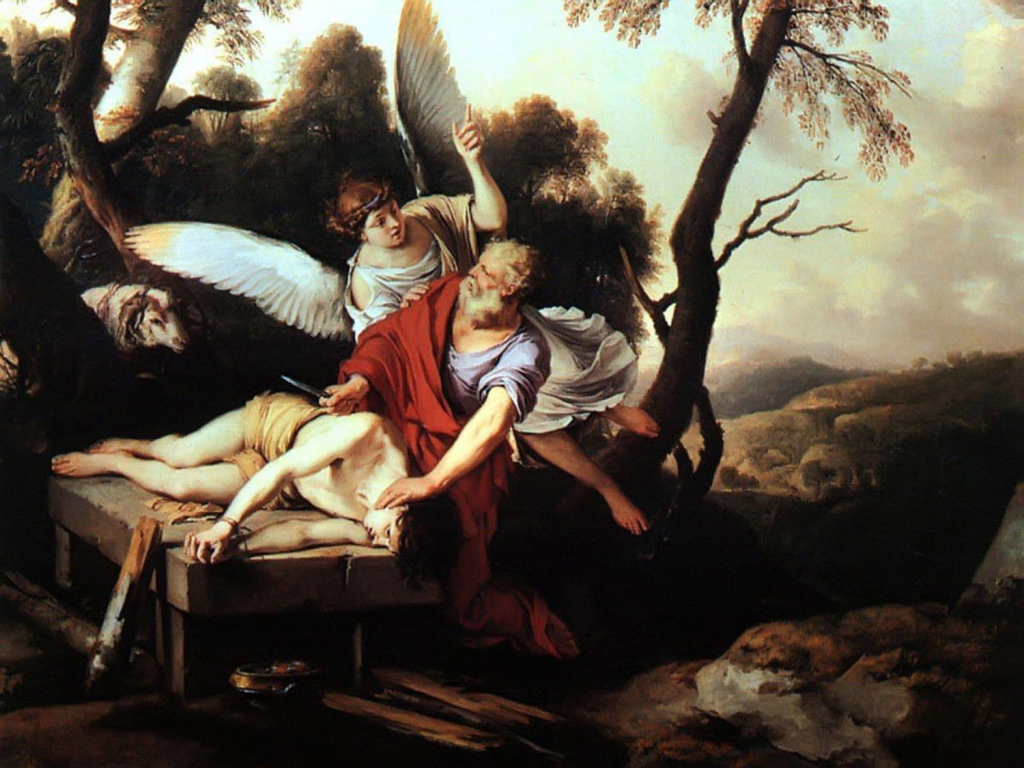
03.01.00.A. THE SACRIFICE OF ISAAC by Godfrey Durand. 1896. Abraham, depicted as holding the knife to sacrifice his one and only son, is the recognized father of Judaism and Christianity. While human sacrifice is strictly forbidden in the Bible, in the pre-biblical period of Abraham, it was a common practice. This event challenged Abraham’s faith to see if he was prepared to do anything for God – a profound test of devotion. However, unknown to him, God never intended to have Isaac sacrificed.
03.01.01 Introduction
It is impossible to comprehend Messianic thoughts and opinions of the Jews without first highlighting important events and persons of the Old Testament and Inter-Testament era. Some topics of conversations and actions by Jesus and His adversaries were deeply rooted in history. The chronological history overview below provides insight to this critical background that shaped the first century Jewish mindset and, therefore, the actions of Jesus.
03.01.02 c. 4000 B.C. +/- Adam and Eve
God created Adam and Eve in the Garden of Eden. They lived in close relationship with God, but soon accepted the temptation of Satan, fell into sin, and lost their close relationship. Since that time the entire history of the Bible has been focused on God and His work of reconciliation of mankind unto Himself. This work of God was completed by the ministry of Jesus the Messiah. Therefore, from the beginning, there was a prophecy predicting a coming Redeemer (Gen. 3:15 cf. Rom.16:17-20). That Redeemer would be Jesus. When Luke wrote his gospel to someone with the Greek name Theophilus (Lk. 1:3), he recorded a genealogy that traced Jesus to Adam since the Greeks believed in a creation account, although not necessarily the narrative found in Genesis.
03.01.03 c. 2100 – 1850 B.C. Abraham
Abraham is the patriarch of the Israelite people who many centuries later became known as the Jews. With his father Terah, Abraham left his home in Ur, approximately 600 miles east of modern Israel, traveled around the northern edge of the Arabian Desert (as it was known in ancient times) to the small city of Salem (modern Jerusalem). They left their flourishing community at the confluence of the Tigris and Euphrates rivers to find a land where a nation could be established free of idolatry. It was in Salem where Abraham (then known as Abram) was welcomed by its king, Melchizedek (Gen. 14). God chose to make a covenant with Abraham and the Judeo-Christian faith began to take shape and promise.
There is no place in the Hebrew Bible (Old Testament) where Jesus was symbolized more than upon Mount Moriah in the story of Abraham and Isaac. God tested the faith of Abraham by asking him to sacrifice his only son Isaac (Heb. 11:17-19), when the young man was 25 years old.[1] This was an event that looked into the future when Jesus, the only Son of God, would die for the sins of the world.[2] Abraham took his only son high upon Mount Moriah, which in the first century was the sacrificial temple site now known as Mount Zion.[3] Isaac was a precious and only child to Abraham, who at this time was in his old age. In obedience, but deep sorrow, he made the decision to obey God and make the sacrifice. Abraham is considered a “type and shadow”[4] of God, as shown: Isaac was dearly beloved of Abraham just as Jesus was dearly beloved by God the Father. Isaac willingly honored His father and allowed himself to be bound and laid upon the altar. Likewise, Jesus willingly honored His Father and allowed Himself to be bound and crucified. Isaac carried the wood to die on the altar just as Jesus carried His cross to die for the sins of humanity.
Abraham had made the decision to sacrifice his most precious gift. Just when he slowly raised his knife for the impending death, a sacrificial ram appeared in a nearby bush and God told him to release his son. Isaac’s life was spared; his life was restored. The ram was sacrificed in Isaac’s place. Centuries later Jesus would die a horrific death, but He would be restored to life. Isaac was the means by which God demonstrated his love and means of provision to Abraham. In ancient times, children were the security of parents in their old age. Abraham’s willingness to sacrifice his only son was symbolic of God the Father demonstrating His love and means of provision to the Jewish people and all humanity through Jesus. Then God and Abraham entered into an everlasting covenant[5] in which God would give him three important promises.
The land promise was developed in the Palestinian Covenant; the promise of descendants was promised in the Davidic Covenant[6] and includes Jesus (a Son of David); and the Blessings Covenant is the New Covenant, also known as the New Testament.[7] The latter was the result of the completed work of Jesus at Calvary. The original Promised Land far exceeds the borders of modern Israel today.
The Old Testament prophets had spoken frequently about the fulfillment of God’s covenants given to Abraham,[8] to David (Ps. 89:1-4; 2 Sam. 7:16), to Jeremiah (Jer. 31:31-34; Ezek. 36:25-30), and to Moses (Deut. 28-30). By the first century, the Jewish people waited anxiously for the Messiah to come and fulfill these eternal and unconditional covenants.
Video Insert >
03.01.03.V The Importance of the Abrahamic and Davidic Covenants to First Century Jews. Dr. Darrell Bock discusses how the first century Jewish people viewed the importance of their two ancient covenants. (03:35)
Furthermore, God promised Abraham that among his descendants there would be a line of kings (Gen. 17:6, 16) who would come from the tribe of Judah and would rule over alien people, including the tribes of Moab and Edom.[9] Yet when his only nephew Lot, left him, Abraham must have wondered, “How can I be the ruler of many nations if I cannot even rule my own house?” As he discovered, the call of God came with blessings as well as difficulties.
The first century Jews recognized a problem concerning the fulfillment of the Abrahamic Covenant because the reigning Herod the Great was not a descendant of King David, but a descendant of the hated Edomites. Neither he nor any of his sons could fulfill the biblical requirement as the true king of the Jews. Hence, the tension was heightened during the days of Jesus for a messiah to come, depose the Herodian Dynasty, end Roman occupation, and fulfill the promises of the covenant. When Matthew wrote his gospel to Jews dispersed in other lands, he recorded a genealogy that traced Jesus to Abraham since he was the patriarch of the Jews. In essence, he made a connection to the covenant. Likewise, the writer of the book of Hebrews affirmed the promises God gave to Abraham (Heb. 6:13-18).
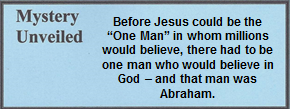
[1]. Josephus, Antiquities 1.13.2.
[2]. See Appendix 6 concerning Old Testament sacrifices and Jesus.
[3]. In Biblical times, “Mount Zion” was one of three hills upon which was Jerusalem was located. The name became associated with the Temple site, but over time was applied to the hill top located in the western part of the Old City of modern Jerusalem.
[4]. See “Type and shadow” in Appendix 26.
[5]. Gen. 12:2-3; 15:17-21; 17:9; 1 Kg. 2:4; 3:8; Micah 7:20; Zech. 2:11; Rom. 9:4; 15:8; 1 Cor. 7:14; Gal. 3:19; Heb. 6:13, 18.
[6]. The messianic title “Son of David” appears in the following three groups of passages in the gospels where it is always reflective of the Davidic Covenant: 1) In various healings by Jesus – Mt. 9:27; 12:23; 15:22; 20:30-31; Mk. 10:47-48; Lk. 18:38-39. 2) In connection of the harassment the religious leaders gave Jesus – Mt. 22:42-43, 45; Mk. 12:35, 37; Lk. 20:41, 44, and 3) The praise the crowds gave Jesus at His entry into Jerusalem – Mt. 21:9, 15; Mk. 11:10. See Rogers, “The Davidic Covenant in the Gospels,” Bibliotheca Sacra. Part 1 of 2. 158-78.
[7]. Fruchtenbaum, Israelology: The Missing Link in Systematic Theology. 575-76; Rogers, “The Davidic Covenant in the Gospels.” 458-78.
[8]. Gen. 12:1-3, 7; 13:14-16; 15:18; 17:6-8.
[9]. Gen. 49:10; 2 Sam. 22:44-51; Num. 24:17-19; Ps. 2.
03.01.04 1876-1446 B.C. Sojourn in Egypt
In 1850 B.C., a severe famine came upon the land of Canaan. The descendants of Abraham traveled to Egypt, where they remained for the next 430 years. The reason they remained in Egypt for this extended period of time, after God promised both land and descendants, was for three reasons:
In Egypt they would grow as God’s Chosen people. The most significant character for the Israelites at this time was Joseph, who was responsible for bringing salvation to not only his extended family, but also to the nation of Egypt. For that reason, he too is seen today as a prophetic picture or “type and shadow” of Christ.[1]
At some point during their stay in Egypt, they became enslaved as the result of a change of monarchs. Later, God, through the leadership of Moses, delivered them out of Egyptian slavery in a miraculous walk through the Red Sea known as the Exodus. The celebration and remembrance of that historical event became known as Passover.
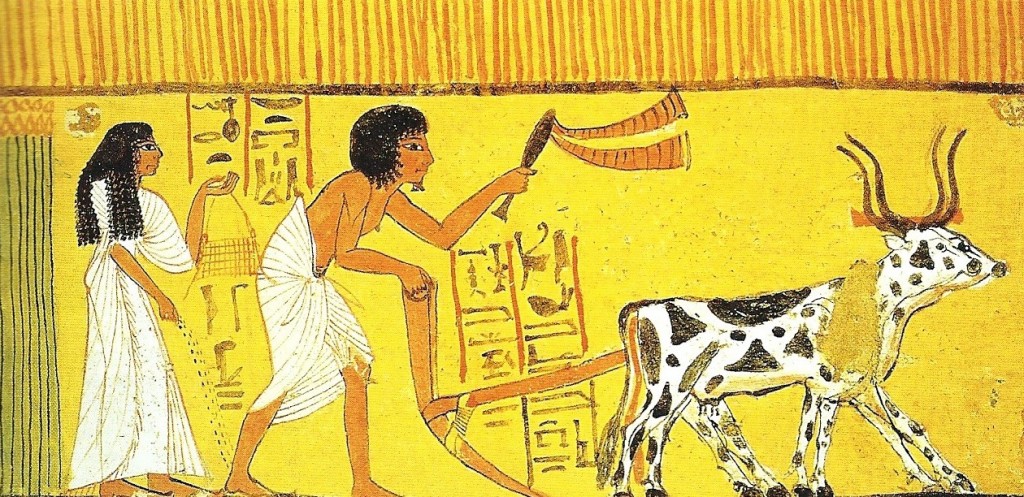
03.01.04.A. ILLUSTRATION FROM AN EGYPTIAN TOMB. Tilling and sowing, a mural from Thebes, Egypt. This shows one of two ways of sowing until the year 1701. Cain, “the tiller” (Gen. 4:2) was the ancestor of those who had livestock (Gen. 4:20).
[1]. See Appendies 2 and 26.
03.01.05 1446 B.C. The Exodus; the Torah; Moses and Balaam Predict the Redeemer
As the adopted son of Pharaoh, Moses was privileged to receive the highest level of education (Acts 7:22) as well as leadership and military training. He was familiar with the Egyptian holy books, including the Papyrus Ebers,[1] and the political and religious systems of his day. Josephus recorded some of his military adventures.[2] The Exodus story of the Israelite children in Egypt and how Moses delivered them from slavery has been repeated for centuries. The celebration of deliverance from death that occurred at this time became known as the Passover. Moses was chosen by God to lead His people through the Red Sea, out of Egypt, and to the Promised Land of Canaan. This event became symbolic of how Jesus would lead humanity out of the slavery of sin into a new freedom in Himself.[3] Among his works is this verse that was considered prophetic of the coming Messiah by the Jews.
The Scepter will not depart from Judah
Or the staff from between his feet
Until He whose right it is comes
And the obedience of the peoples belongs to Him
Genesis 49:10
Moses was personally given the Ten Commandments from God on Mount Sinai. Later he wrote the first five books of the Hebrew Bible that includes history as well as the Mosaic laws. These laws are foundational to the faith of Jews, Samaritans, and Christians. The Torah is considered to be the most sacred of all Jewish writings. The fact that Jesus often made reference to the Torah is indicative of its continued importance.
Due to the many similarities of his life and accomplishments, Moses is seen today by Christians as a “type and shadow” of Jesus.[4] However, to first century Jews, their concept of a Messiah according to Deuteronomy 18:15 was someone who would be like Moses. The key word is “like” which does not mean “identical to,” so when Jesus arrived on the scene, they had difficulties accepting Him.
The Lord your God will raise up for you a prophet like me from among your own brothers. You must listen to him.
Deuteronomy 18:15[5]
In his history of the Israelites, later known as “Jews,” Moses mentioned a pagan prophet (or seer) by the name of Balaam. Moses recorded a prophecy given by Balaam in the book of Numbers that would become significant to the Parthian magi centuries later. An interesting event happened when Balaam, believed he had sufficient demonic powers to curse the Israelites and manipulate their God. So when he was asked by an enemy to curse them, God intervened and told him to bless the Israelites instead, curse the enemy who made the request, to and give a prophecy that is recorded in Numbers 24:17 concerning a future Redeemer. It reads,
I see him, but not now;
I perceive him, but not near.
A star will come from Jacob,
And a scepter will arise from Israel.
He will crush the forehead of Moab,
And strike down all the Shethites.
Numbers 24:17
To first century Jews, no biblical figure was of greater significance in the affairs of daily life than was Moses. All religious rites and beliefs began with his writings. He recorded the Mosaic Code (Ten Commandments, and the 613 laws affecting all areas of life).[6] By the first century, however, these laws had taken a secondary position to the Oral Law. Therefore, the major conflict between Jesus and the Pharisees was because Jesus held the Mosaic Code in the superior position, while the Pharisees held their Oral laws in superior position. On an important side note, the Church has adopted a Roman view of Law, in that it means restriction and therefore, bad, while the Hebrew Bible views Law as Instruction and freedom and, therefore, good.
However, because Moses had written these three messianic passages (Gen. 49:10; Deut. 18:15; Num. 24:17), not only were first century Jewish people waiting for a messiah, but for the previous fifteen centuries, wherever they wandered, they told others of the coming messiah. As will be seen, the second and first century B.C., people everywhere in the ancient Middle East were expecting Him, including the three magi who came from the east.
Now concerning the non-Israelite prophet, some critics have discounted the Balaam account as mythological folklore, saying that he never existed. However, in 1967 archaeologists digging in Deir’ Alla in Western Jordan, made an interesting discovery of a temple. These ancient ruins are situated about five miles east of the Jordan River and less than one mile north of the Jabbok River. Evidently the ancient seer had incredible fame. Josephus said he lived by the Euphrates River,[7] yet he was remembered and honored centuries later and hundreds of miles to the west. In these ruins a painted inscription was found of a prophecy given by the same Balaam mentioned in Numbers 22-24 by Moses. This prophecy is considerably different from the biblical narrative, but it does make reference to the “Shaddai gods,” which is close to the Hebrew El Shaddai, meaning “God Almighty.” This inscription was dated to 840 – 760 B.C., and portions of it are, understandably, missing while others are difficult to read. However, various sections are of sufficient quality that, with sophisticated scientific equipment, could be read and was translated as follows:
1 [VACAT] The sa]ying[s of Bala]am, [son of Be]or, the man who was a seer of the gods. Lo! Gods came to him in the night [and spoke to] him 2according to these w[ord]s. Then they said to [Bala]am, son of Beor, thus: “Let someone make a [ ] hearafter, so that [what] you have hea[rd may be se]en!” 3 And Balaam rose in the morning [ ] right hand [ ] and could not [eat] and wept 4aloud. Then his people came in to him [and said] to Balaam, son of Beor, “Do you fast? [ ] Do you weep?” And he 5said to them, “Si[t] do]wn! I shall inform you what the Shad[dayin have done]. Now come, see the deeds of the g[o]ds!. The g[o]ds have gathered 6and the Shaddayin have taken their places in the assembly and said to Sh[slave, thus:] ‘Sew the skies shut with your thick cloud! There let there be darkness and no 7perpetual shining and n[o] radiance! For you will put a sea[l upon the thick] cloud of darkness and you will not remove it forever! For the swift has 8reproached the eagle, the voice of vultures resounds. The st[ork has ] the young of the NHS-bird and ripped up the chicks of the heron. The swallow has belittled 9the dove, and the sparrow [ ] and [ ] the staff. Instead of ewes the stick is driven along. Hares have eaten 10 [ ]. Freemen [] have drunk wine, and hyenas have listened to instruction. The whelps of the 11 f[ox] laughs at wise men, and the poor woman has mixed myrhh, and the priestess 12 [ ] to the one who wears a girdle of threads. The esteemed esteems and the esteemer is es[teemed. ] and everyone has seen those things that decree offspring and young. 15 [ ] to the leopard. The piglet has chased the young 16[of] those who are girded and the eye ….’”
Balaam Deir Alla Inscription.[8]
“Balaam, son of Beor.” Balaam must have been a prophet of excellent reputation, in that kings consulted him and asked him to curse enemies prior to war.[9] The ruins of Tel Deir ‘Alla revealed archaeological evidence of Balaam’s existence. Archaeologists believe that originally there was a long narrative on the wall with a minimum of fifty lines of writing. While portions were destroyed by earthquakes, among the 119 remaining plaster fragments with red and black writings the name of a prophet Balaam, son of Beor” is mentioned three times – just as mentioned in the Bible.[10] But most important, his prophecy of biblical record (Num. 24:17) was responsible for the eventual visit by the Parthian magi to Jesus, and in part, the anticipation of a Messiah by Jewish people.
“The Shaddayin.” Some scholars believe these were deities of the pagan world.[11]
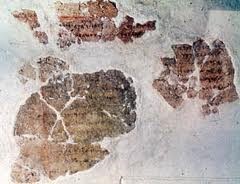
03.01.05.A. PLASTER FRAGMENTS OF THE BALAAM TEL DEIR ‘ALLA INSCRIPTION. Sufficient plaster fragments with inscriptions were discovered in Deir ‘Alla, Western Jordan, to authenticate the existence of a non-Israelite prophet by the name of Balaam. Photo by Google Images.[12]
[1]. The Papyrus Ebers, written about 1552 B.C., contains over eight hundred prescriptions and remedies for various human aliments. Egyptian physicians were highly skilled in diagnosing illnesses, but their prescriptions of primitive superstitions were deadlier than the illnesses they tried to cure. The directives for cleanliness prescribed by Moses were radically different than that of the Egyptians or Babylonians. Obviously, this is indicative of a different source of information. Furthermore, he did not include any directions to perform exorcisms and incantations as were popular among the Egyptians. See Ben Hobrink, Modern Science in the Bible. 2-3, 5. As a whole, the Egyptian worldview was focused on death, and the worship of deities controlled life and death.
[2]. Josephus, Antiquities 2.10.1.
[3]. See Appendix 3.
[4]. See Appendix 2 and 26; an example of “type and shadow” is found in Hebrews 10:1a, “Since the Law has only a shadow of the good things….”
[5]. Emphasis mine.
[6]. The 613 laws were observed only during the times of the tabernacle or temple. Today, only 271 of those Mosaic commands can be observed. See Parry, The Complete Idiot’s Guide to the Talmud. 221.
[7]. Josephus, Antiquities 4.6.1.
[8]. Translation published by P. Kyle McCarter Jr. “The Balaam Texts from Deir ‘Alla: The First Combination.” Bulletin of the Schools of Oriental Research. 239 (1980). 49-60; http://en.wikipedia.org/wiki/Deir_Alla_Inscription. Retrieved November 10, 2012.
[9]. Balaam is also mentioned negatively in 2 Peter 2:14-15 and Revelation 2:14.
[10]. Fruchtenbaum, The Jewish Foundation of the Life of Messiah: Instructor’s Manual. Class 4, page 9.
[11]. http://jewishchristianlit.com/Texts/ANEproph/aneBalaam.html. Oracle of Balaam translated by Gildas Hamel. Retrieved July 18, 2014.
[12]. https://www.google.com/#hl=en&sugexp=les%3B&gs_nf=3&gs_mss=deir%20alla%20i&tok=M_9W2yMghuzYK2vUSojXkQ&pq=deir%20alla%20inscription%20wiki&cp=15&gs_id=25&xhr=t&q=deir+alla+image&pf=p&tbo=d&sclient=psy-ab&oq=deir+alla+image&gs_l=&pbx=1&bav=on.2,or.r_gc.r_pw.r_qf.&fp=74f684b921f60f2b&bpcl=38093640&biw=2025&bih=999. Retrieved November 10, 2012.
03.01.06 1446 – 1050 B.C. +/- Judges Ruled God’s PeopleAdd AppendiA
During the four centuries after the Israelites entered the Promised Land, God ruled His people with a series of judges. They were twelve independent tribes who formed a loosely knit confederacy, squabbling during times of peace but fighting together against common enemies whenever the need arose. The significance of this period in history is that this was when God ruled His people – or tried to rule His people. They were an unruly bunch who grumbled and wanted a king. In fact, during these four centuries they committed some horrible acts of violence against each other and God. This history was written with kind words in the last chapter of Judges that says that in those days Israel had no king and everyone did as he or she wanted to do (Judg. 21:25). Therefore, since they wanted a king like other nations, God gave them what they wanted – and soon the first king was anointed for the position.
Unit 03
Historical Background
Chapter 02
First Temple Period And Exile (1040 – 515 B.C.)
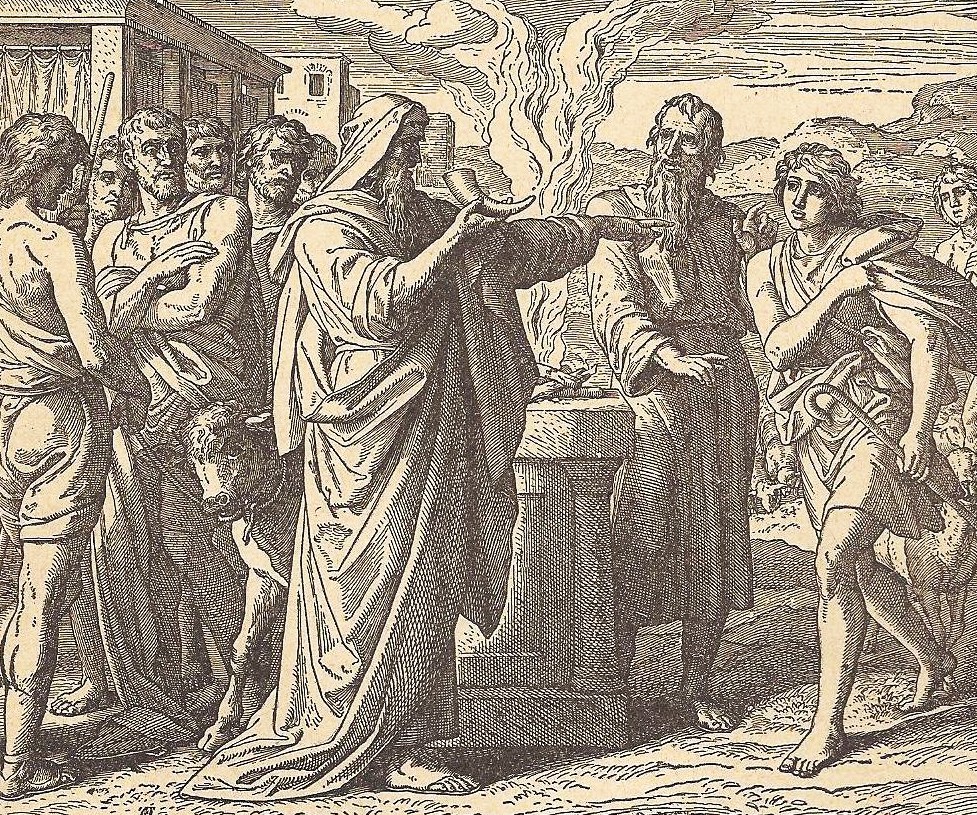
03.02.00A. SAMUEL ANOINTS DAVID by Godfrey Durand. 1896. King David was, without question, the most important person in Jewish history, second only to Moses. First century Jews in Israel believed that the messiah (small “m” because they did not consider him as deity) would be like King David and restore the lost Davidic Empire. That perception made accepting Jesus as their “Anointed One” extremely difficult.
03.02.01 1049-931 B.C. The United Monarchy
The term “United Monarchy” refers to the reigns of Kings Saul (reigned 1049-1009 B.C.), David (reigned 1009-969 B.C.), and Solomon (reigned 969-931 B.C.). A few short years after Solomon’s reign, the empire was divided.[1]
King Saul
The first king was Saul who united the twelve unfaithful, bickering, individualistic Israelite tribes into a single nation (1 Sam. 11:12-15). At the time, the land was still filled with idol-worshiping Canaanites who practiced child sacrifice and other horrible acts. He and his armies were, in effect, instruments of God to bring justice upon those who destroyed young innocent lives and practiced idolatry. These Canaanite tribes included the Amorites, Amalekites, the nomadic Midianites, and several others. But the most powerful enemies were the Philistines who lived in the modern-day Gaza Strip. Saul strengthened the confederacy and defeated nearly all of them, but failed to drive them out of the land.
However, sometimes too much success breeds failure, and he soon found himself with some moral failures. As a result, God began to raise David as his replacement. When Saul became aware of this, a civil war broke out. As was the custom of the time, kings normally asked their prophets to inquire of God for any directives they should follow. Ironically, while his name Sa ‘uli means ask insistently, as if asking Yahweh (God), he soon was asking counsel from the witch at Endor. Saul was a man whose life began with great promise and opportunity, but ended with a marked decline of his own spiritual and moral values, and finally, suicide. In contrast, David very frequently consulted God, but Saul rarely did. Their lives and the results of their leadership clearly reflect this significant difference.
King David
King Saul was followed by David, yet neither one was a pillar of moral strength, but David did have a repentant heart for which God honored him. His name in Hebrew is Dawid which means doubtful.[2] For whatever reason he was given that name, he certainly rose above it to become the champion of military commanders in Israel’s history. At a time when there was little or no change within any culture, he introduced massive radical changes to the benefit of the Israelites. He instilled a sense of nationalism and began the establishment of an international super-power which was completed by his son Solomon. So powerful was Judaea in ancient history that future generations, even in the time of Christ, reflected upon its history. In four military phases, David transformed his people from a dozen squabbling tribes to an international superpower and empire.
As a result of his incredible victories, King David controlled all of the international trade that crossed his kingdom; a land bridge between the continents of Asia, Africa, and Europe. To the east was the great northern section of the Arabian Desert and to the west was the Mediterranean Sea. The major routes were the north-south route of the King’s Highway located east of the Jordan River; the Spice Route that went from Southern Arabia north along the eastern side of the Red Sea to the Mediterranean Sea to David’s shipping fleet; and the “Way of the land of the Philistines” (Ex. 13:17; Num. 20:17), an international highway that went from Damascus to Capernaum and southward on to Egypt.[3] Since bandits were numerous, caravans paid huge taxes for the protection of their goods, camels, and men.
Military success translated into economic success, not only for himself, but also for his people. David transported copper from Egyptian mines, silver from the Taurus Mountains in Asia Minor, silver and gold from East Africa, spices from Arabia, and purple dyes[4] from nearby Phoenicia. He utilized existing trade routes that had been established centuries before. The king simply conquered and took control of this existing wealthy enterprise.[5] The kingship of David also resulted in exceptional cultural changes, freedom, and wealth for the Israelites. No longer did they have to pay taxes, or tribute, to any foreign pagan king. Never in ancient history had a group experienced such a dramatic change within the short time frame of a single generation, as did the Israelites. Generally, sudden and dramatic social changes were extremely negative, usually resulting from a military conquest in which the defeated people were either killed or enslaved. Victors of any nation never accomplished what David created in a mere forty years.[6]
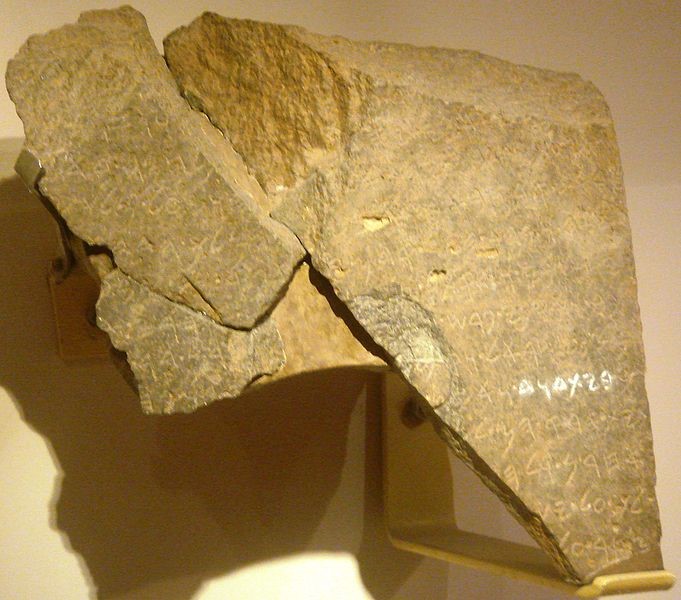
03.02.01.A. THE “KING DAVID FRAGMENT.” This inscription, known by archaeologists as the “Tel Dan Stele,” (a/k/a “Tel Dan Stela”) mentions the House of David on line 9. It consists of three fragments (discovered in 1993 and 1994) that refer to an unnamed king who boasts of his victories over the king of Judaea and his ally, the king of the “House of David.” It is the first artifact to be found in Israel that mentions the name David. Photo by Wikipedia Commons.
Translation of the “King David Fragment” inscription is as follows:
1.[ ]…[ ] and cut [ ]
2. [ ] my father went up [ ] he fought at […]
3. And my father lay down; he went to his [fathers]. Now the king of I[s]/rael had penetrated
4. into my father’s land before. [But then] Hadad made me king,
5. And Hadad marched before me. So I went forth from [the] seven[…]/s
6. of my rule, and I killed [seve]nty kin[gs] who had harnessed thou[sands of cha]/riots
7. and thousands of cavalry. [And I killed …]ram son of […]
8. the king of Israel, and I killed […]yahu son of [… the ki]/ng of
9. the House of David. And I made [their towns into ruins and turned]
10. their land into [a desolation …]
11. others and […Then…became ki]/ng
12. over Is[rael…And I laid]
13. siege against […]
King David Fragment Inscription[7]
The name “Hadad” is a pagan deity.[8] It should be noted that not all boastings by kings reflected truthful events. Amazingly, since the 18th century, critical scholarship has perpetuated the myth that King David never existed; that he is an imaginative figure of creative biblical writers.[9] However, they were silenced in 1993 and 1994 when a ninth century B.C. stele was discovered with the king’s name inscribed on it.[10] He was just as the biblical narrative describes. This inscription discredits critics who have stated that King David was a mythical figure who never existed.[11]
More importantly, in the ancient Middle East dignity was a sacred honor. King David established dignity and honor for God’s Chosen People. No longer were they recipients of degrading jokes. The Jewish people of the first century, who were reduced to economic slavery,[12] were expecting a Messiah who would to re-establish the David Empire as a wealthy international superpower and restore their dignity.
David was known not only for his administrative skills in forging twelve semi-disassociated tribes into an empire, but also for his many Messianic Psalms. For example, in Psalm 2 and 89 he wrote of a “Messiah” who would be the subject of much discussion. This occurred as predicted. He also described the death of Jesus in Psalm 22:14-18. Note the repeating themes or ideas of poetic Hebrew parallelisms.
14 I am poured out like water,
and all my bones are disjointed;
My heart is like wax,
melting within me.
15 My strength is dried up like baked clay;
and my tongue sticks to the roof of my mouth;
You put me into the dust of death.
16 For dogs[13] have surrounded me;
a gang of evildoers has closed in on me;[14]
They pierced my hands and my feet.
17 I can count all my bones;[15]
people stare and gloat over me.
18 They divided my garments among themselves,
and they cast lots for my clothing.[16]
Psalm 22:14-18
David’s literary works portray a man who rose from being a shepherd to a powerful monarch, yet one who experienced some horrific failures which were followed by the discovery of God’s love. He may not have realized that some of his words were “messianic.” In fact, not all of the messianic psalms were recognized in the first century as “messianic.” Some, such as the first line of Psalm 16:10 greatly perplexed the rabbis. Only after the resurrection of Jesus did this passage find fulfillment and understanding.
For You will not abandon me to Sheol;
You will not allow Your Faithful One see decay.
Psalm 16:10
The significance of King David to first century Jews and the identity of Jesus cannot be overstated. They were expecting the messianic Son of David to repeat all the great things King David had done. This was especially influential in first century Jewish thinking in light of the Davidic Covenant.[17] That covenant was similar to the Abrahamic Covenant, with the exception that it contained the additional clause of 2 Samuel 7:13-15, which promised dominion over alien people (2 Sam. 22:44-51; Ps. 2).[18] David was God’s anointed one (Ps. 2:2) and, as such, he was both priest and king (cf. Ps. 110); foreshadowing the function Jesus would hold in the future.[19] In essence, first century Jewish people expected a messiah, who would,
With four divine promises like these, no wonder that the Jews were anxious for their “son of David.” The history of Israel was never as glorious as it was during the reign of its three major monarchs. King Saul forged the birth of a great nation, but David completed the task. David instilled a sense of nationalism and began the establishment of an empire which was completed by Solomon. Yet while the ancient empire covered an enormous land mass, neither David nor Solomon encompassed all the land God promised to Abraham, Isaac, and Jacob.
Ironically, a few years before Jesus was born, Herod’s Kingdom became close in size to the Davidic Empire. This increased the speculation that the son of David would soon come and take control of the kingdom. But it was not to be.
In the first century, the Jews carefully observed Jesus and attempted to reconcile Him with their preconceived ideas of the son of David. But Jesus obviously did not fit those ideas of a military-messiah, and they certainly did not expect a Messiah would come to redeem them from their sins.
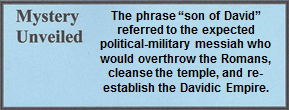
Once the military actions ceased and the Davidic Empire was established, God made a covenant with David that established his dynasty as God’s choice to rule His people forever (2 Sam. 7:4-17). This covenant, known as the Davidic Covenant, has three features.
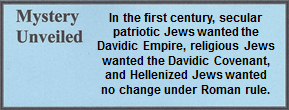
In summary, there were two incredibly events that occurred at this time that were important to the Jewish people of the first century.
King Solomon
The third king of the united monarchy was David’s son, King Solomon, who ruled during the golden age of Israel. His was a time of great prosperity and peace. He is best remembered for building the temple in Jerusalem that carried his name (2 Chron. 3:1). He enjoyed a lavish lifestyle, a huge army, and many building projects, all of which cost more than he earned from international trade and taxes from traveling caravans. He, therefore, imposed high taxes on his people and drove the nation into debt. That national debt became the primary reason his nation split into two independent sovereign states after his death. While the Lord gave him great wisdom, his decisions concerning high debt, and multiple wives and concubines clearly indicate that he failed to use that wisdom.
He expanded international trade that included a partnership with Hiram, the Phoenician king of Tyre. Together they operated a fleet of merchant ships in the Red Sea and along east Africa. Archaeological discoveries indicate that Solomon operated copper mines, which explains his close ties with Hiram. The Phoenicians were the world’s best craftsmen at copper smelting and refining as well as seamanship. Little wonder then, that the writer of First Kings said that the chief metalworker of bronze objects in the temple was a Tyrian by the name of Hiram (not related to the king of Tyre; 1 Kgs. 7:13-45).
The radical and successful transformation of the Israelite nation in such a short time came with a heavy price tag. The massive building project required not only taxation, but slaves as well. Solomon, to protect his new found wealth, enlarged his military which required more taxes and increased his national debt. Any nation that follows this economic cycle soon fails, as did Solomon’s Empire. Like Saul, he too fell into a moral and spiritual free-fall; his life ended in apostasy and idolatry (1 Kg. 12:1-20). He was blessed with God-given wisdom, but near the end of his reign he failed to use it. His life ended in tragedy and soon his empire would collapse.
Solomon’s influence in the days of Jesus was limited, unlike his popular father. Nonetheless, there are two points in the gospels that are worthy of consideration.
[1]. Historians disagree slightly on the reigning dates, but each king reigned 40 years.
[2]. Cullman, “David.” 1:364.
[3]. By Roman times, the “Way of the land of the Philistines” was known as the Via Maris, and it went through the evangelical triangle where Jesus did most of His teaching.
[4]. According to Josephus, large quantities of purple (or scarlet) fabric were required for the temple curtains which were replaced every few years (Wars 6.8.3; 390). Some scholars believe that the purple (or scarlet) robe placed on Jesus (Mt. 27:28) was a soldier’s cloak.
[5]. Keller, W. The Bible as History. 4.
[6]. Cullman, “David.” 1:364-69.
[7]. The line-by-line translation by Lawrence J. Mykytiuk (published 1994).
[8]. http://en.wikipedia.org/wiki/Tel_Dan_Stele. Retrieved October 27, 2012; See also Bryant G. Wood, “New Inscriptions Mention House of David.” Bible and Spade. 119-21; and Avraham Biran and Joseph Naveh, “An Aramaic-Stele Fragment from Tel Dan.” Israel Exploration Journal. 43 (1993): 81-98.
[9]. King David is among fifty biblical names whose existence has been verified by archaeological studies in a published article by Lawrence Mykytiuk titled, “Archaeology Confirms 50 Real People in the Bible.” Biblical Archaeology Review. March/April, 2014 (40:2), pages 42-50, 68 (see 03.02.01.A below). This archaeological evidence confirms the historical accuracy of the biblical timeline. For further study see the website for Associates for Biblical Research, as well as Grisanti, “Recent Archaeological Discoveries that Lend Credence to the Historicity of the Scriptures.” 475-98.
[10]. http://en.wikipedia.org/wiki/File:Tel_dan_inscription.JPG, Retrieved October 27, 2012. See also Gary A. Byers. “The Tell Dan Stela.” 121.
[11]. For an interesting article on the fallacies of deconstructionists approach to biblical traditions, see Anson Rainey, “The House of David and the House of Deconstructionists: Davies is an Amateur Who ‘Can Safely Be Ignored.’” Biblical Archaeology Review. 20:5 (Nov. Dec. 1994.) 47.
[12] The subject of high taxation that resulted in economic slavery is presented by Josephus, Antiquities 17.11.2 (307-308). See also 02.03.03 “Economy” and 03.06.04 “4 B.C. The Death of Herod the Great.” God hates slavery, but it was part of the human predicament which is why He permitted slavery for a limited duration of seven years (Ex. 21:2 ff.; Deut. 15:12). In Amos 2:6 He brought judgment upon Israel for the enslavement or its own people. The way the Apostle Paul dealt with Philemon, demonstrates how God changed the slavery-based economy by changing the hearts of men. See also Sanders. “Jesus in Historical Context.” 430.
[13]. The term “dongs” or “Dogs” was a Hebrew nickname for non-Jewish people. This theme is repeated on the next line.
[14]. The psalm writer recorded the emotions of his life, no doubt totally unaware of the fact that he was recording prophetic words that would later be ascribed to Jesus.
[15]. The agony of dying on a cross stretched the human body to the point that it felt as if the joints were coming apart.
[16]. Exact description of what happened to Jesus. See Mt. 27:35.
[17]. Cullman, “David.” 1:368-69; Rogers, “The Davidic Covenant in the Gospels.” 458-78.
[18]. Fruchtenbaum, Israelology: The Missing Link in Systematic Theology. 629-33; Wiseman, “Abraham.” 1:6.
[19]. Merrill, Kingdom of Priests. 276; Terrien, The Elusive Presence. 295-96.
[20]. Fruchtenbaum, Messianic Miracles. 4; Fischer, The Gospels in Their Jewish Context. (Lecture on CD/MP3). Week 10, Session 2.
[21]. Messiah is spelled with a lower case “m” because the Jewish people had not applied deity to the name. Messiah with an upper case “M” is a reference to Jesus as God. For a description of the three messianic miracles, see the video link 06.03.08.V.
[22]. Fruchtenbaum, Israelology: The Missing Link in Systematic Theology. 632; Rogers, “The Davidic Covenant in the Gospels.” 458-78.
[23]. Josephus, Antiquities 8.2.5.